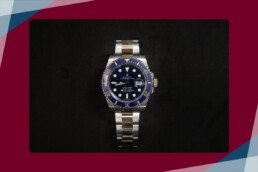Insuring Your Rolex: How to Buy Personal Property Insurance
Gaining the finer things always takes a little extra effort, but it has never been this difficult to buy a Rolex. As prices and demand soar, it’s more important than ever to protect your investment if you finally get your hands on one.
Of course, a Rolex isn’t the only easy-to-lose, hard-to-replace item out there. Whether it’s a Rolex, Bulgari earrings, or a Coach purse, it’s not always easy to overcome a loss from theft or damage. That’s why personal property insurance is crucial to cover those hard-earned and treasured valuables.
We’ll discuss the process of insuring luxury items and what you can do to earn peace of mind while using your high-end gear.
What Does Homeowner’s Insurance Cover?
The first step in determining the amount of coverage you need is reviewing what you already have.
If you have homeowner’s or renter’s insurance, you likely have some coverage for valuables. But in most cases, a standard homeowner’s policy won’t be enough to cover the cost of an expensive piece.
Review your homeowner’s insurance policy to understand the inclusions and exclusions. You’ll have either a named-peril policy or an all-peril policy. A named-peril policy will show included occurrences while an all-peril policy, though general, will still detail some exclusions.
Incidents that could lead to the loss of your luxury items but have protection under most homeowner’s policies include:
- Burglary
- Fire
- Wind and hail
- Lightning
- Vehicle and airplane damage
Policies usually exclude certain perils, like flooding, water damage, and tornados. If you live in a high-risk area, you may need additional coverage, which often comes with a deductible.
Luxury Item Limitations in Homeowner’s Policies
Small valuables, particularly jewelry, are treated differently than many other items in the home, and you’ll have to pay careful attention to limits and exclusions.
Many homeowner’s policies have a per-item coverage sub-limit. It’s a lower maximum payout for specific categories, usually around $1,500-$2,500 with jewelry. If you lose a ring in a fire, you’ll be fine if it only costs $1,000, but you’ll have to cover the difference if it’s more than your limit.
The more pressing concern with luxury items is that they’re small and portable. “Mysterious disappearance” is a common exclusion on most homeowner’s policies, so a missing Rolex won’t have any coverage unless you had a break-in.
It’s easy to lose something while you’re away from your home. Does homeowner’s insurance cover items that aren’t in the house when they’re lost or damaged?
Fortunately, many policies cover lost items while you’re on vacation, away at school, or out running errands. But the coverage amount for off-premises losses is usually a fraction of the normal amount. For example, you may have a $1,500 sub-limit for the item in your home, but only a $500 limit if you lose it while you’re out.
Off-premises losses or damage may not be covered in all situations. It’s essential to review your plan details before traveling with valuables.
Personal Property Insurance Options
Homeowner’s insurance and personal property insurance are synonymous by many people. Personal property insurance covers a broader range of general and specialized policies.
Before you look at additional policy endorsements or separate insurance plans, ask your insurance agent about raising sub-limits on certain items. Double coverage may be possible on certain categories, or they could recommend an upgraded policy if you have many valuables needing additional insurance.
Scheduled Personal Property
A scheduled personal property endorsement is a “floater” policy, an itemized approach to setting up your insurance policy. You can use this for insuring your Rolex or any other valuables, including fine art, firearms, and sports gear.
If you have a high-dollar item that needs a better limit and protection against a wider variety of perils, scheduling your items is the best place to start.
To schedule your personal property, you will usually need to provide proof of purchase and have your item appraised. You can often get help finding an appraiser near you through your insurance company. An appraisal is crucial for determining the value of certain high-value pieces, such as collectible items.
Scheduling your items will usually increase the item’s coverage limit and the number of scenarios that warrant a claim. You may be able to cover against a mysterious or accidental loss, and you’ll keep your payout maxed out even if you suffer a loss away from home.
By endorsing an existing policy, you may get a lower per-item deductible. The enormous benefit, however, is you keep all of your insurance in one convenient place, and you could save by bundling your policies.
Specialized Insurance
If you need help insuring your Coach purse or other purchase, retailers may offer protection plans to cover accidental damage. Plans often have no deductible and you get full replacement against a variety of claims that aren’t covered under your homeowner’s policy.
Protection plans can get expensive, and they rarely cover theft or disappearance. If you want broader coverage outside of a scheduled endorsement of an existing policy, you may buy specialized insurance.
Specialized insurance is provided by many regular insurance companies and some niche businesses. You can buy a separate policy specifically for jewelry or fine art, along with many other high-value categories. These plans can offer high coverage amounts and comprehensive all-risk protection.
Actual Cash Value Vs. Replacement Value
Many homeowner’s policies go by actual cash value (ACV) on personal property, meaning they payout the cost of an item minus depreciation. For a $3,000 watch, it may depreciate to $1,500 by the time you have to make a claim. The insurance company will only pay out the actual value of it, leaving you to make up the rest to replace it.
When you’re ready to schedule an item, pursue a replacement cost option. The premiums are higher on these plans, but you get the benefit of a full payout no matter how much the item is worth when it’s damaged or lost. If you pay $3,000 for an item and lose it five years later, you’ll still receive the full $3,00 payout.
Find the Right Personal Property Insurance
Figuring out the right protection for your valuables starts with understanding their worth. Make a list of all of your valuables with prices and receipts where possible. If you’re unsure of an item’s value, have a professional appraisal to know how much coverage you need.
When you know how much value you have, talk to an insurance agent about the best personal property insurance option. At the Soden Agency, we have access to an exhaustive catalog of individual and combination policies to get the customized insurance you deserve. Contact us today to learn how we provide protection to fit your needs, goals, and budget.
Related Articles
The Importance of Contractual Risk Transfer in Contractor/Subcontractor Relationships
In the construction industry, managing risk is crucial for the success and sustainability of any project. Contractual risk transfer is a vital strategy…
What Are Group Captives?
Group captives are a form of captive insurance where multiple organizations from similar industries form a single insurance entity. Unlike…


